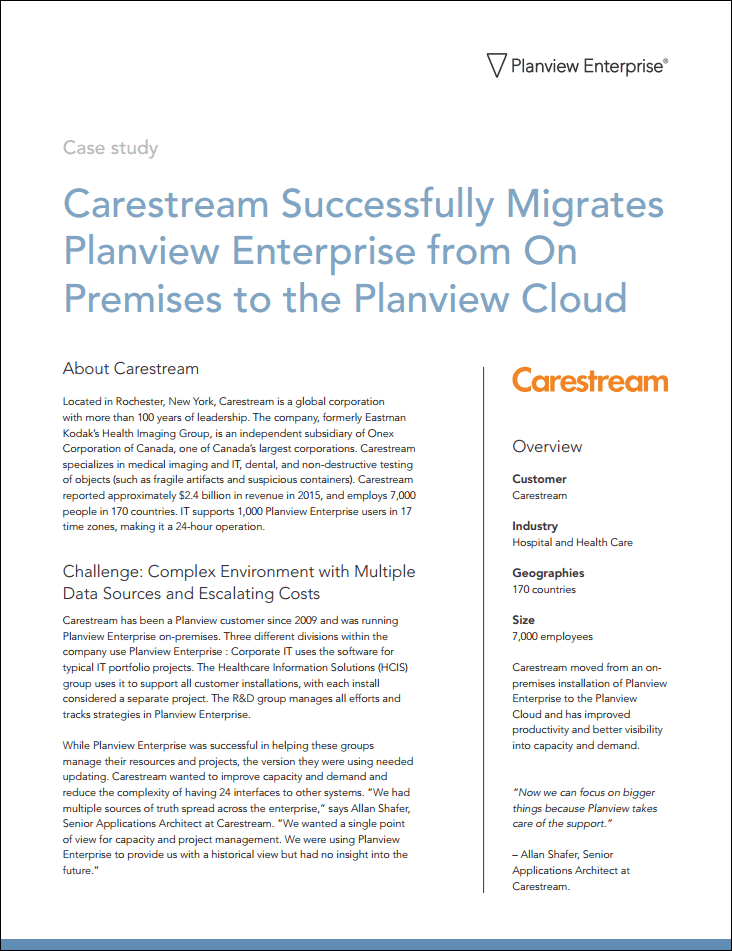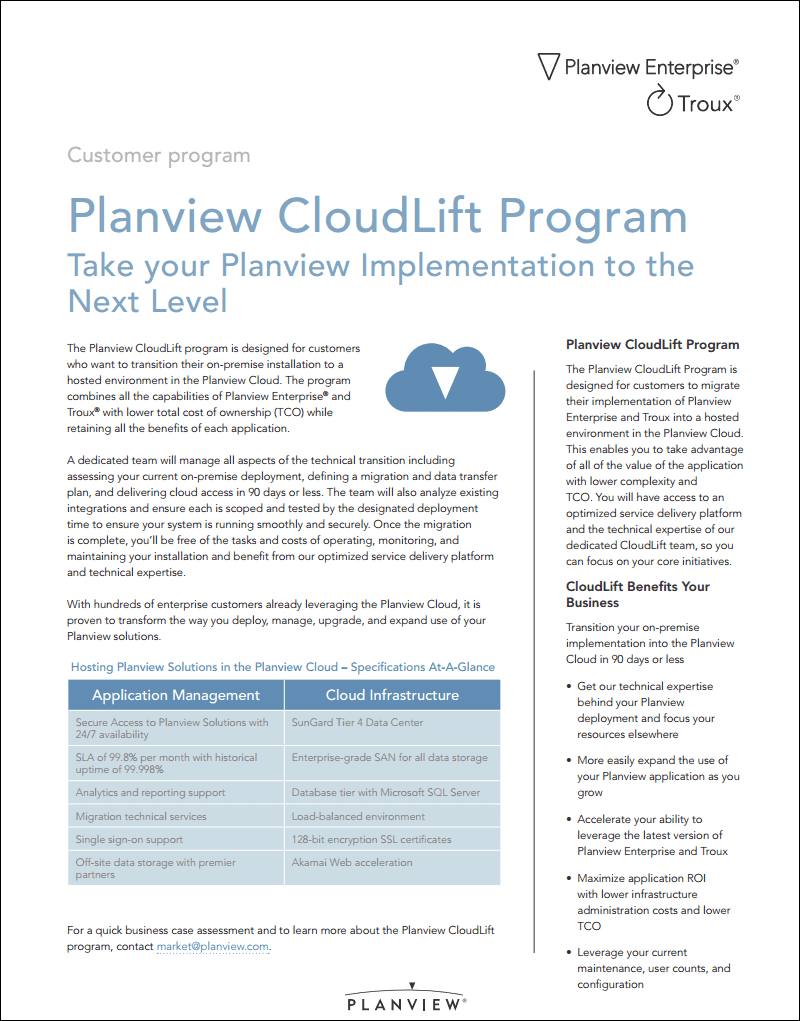
In my last post, Everything You Already Thought You Knew About the Cloud (But Were Afraid to Ask), I talked about how, contrary to what every article, blog, analyst, journo, talking head, TV show, tweet, and… well, basically every single thing in the world would have you believe, not every single company has every single application in the cloud yet.
There are sound reasons many companies delay the move. Read Carestream’s story on their move from an on-premises installation of Planview Enterprise to the Planview Cloud. Complex security policies, tending to other fires, and, quite simply, wanting to put off the complicated processes that can be involved with some applications.
For those in the latter category, I’d like to introduce you to my favorite program that we’ve developed to help our customers when they do choose to migrate: Planview CloudLift.
When we introduced the cloud version of Planview Enterprise several years ago, we saw how many of our customers recognized the advantages of moving to this flexible and scalable environment. We also saw that quite a few others had to balance that with, among other things, the “hassle factor.” The idea that, while moving an on-premises application they relied on every single day to the cloud would deliver great benefits, actually making this happen was one more item on an ever-growing checklist.
If there’s anything we are here, it’s customer-focused. So we created CloudLift as a way to package up the best of everything that would speed cloud migration and help our customers be successful.
In short, CloudLift is a proven approach to migrating Planview Enterprise and Troux from on-premises to the hosted Planview cloud, combining all the capabilities of our customers’ applications with a lower TCO and a higher quality of service. The package includes:
- Migration of the implementation into the Planview Cloud – for most, in 90 days or less
- Access to an optimized service delivery platform for higher performance
- The technical expertise of our dedicated CloudLift team, so you can focus elsewhere
- The ability to more easily add users and capabilities cost-effectively
- Updates to the latest versions sooner than before
- Higher application ROI with lower infrastructure admin costs and lower TCO
- High redundancy and security
Planview CloudLift Use Cases
So how does this play out in the real world? Here are two examples I’d like to share with you.
- An HR management company used CloudLift for one particular reason. Their product development team uses Planview Enterprise to help manage its product innovation cycle; the company’s product director was excited about specific features in the latest release of Planview Enterprise that she felt could be the game-changer in how they went from concept to launch.However, with their on-premise implementation of Planview Enterprise, their IT team told them it would be quite a while before they could roll out these new features. Collaboration between the customer’s IT team and product development organization and my CloudLift team generated an accelerated CloudLift implementation that delivered results everyone was happy with. IT not only didn’t have to manage the on-premise instance anymore, it saw a cut in hosting and resourcing costs; and the product organization was able to use the features that were part of its strategic roadmap on time.
- A healthcare company that had been using Planview Enterprise for many years recently used CloudLift to make the move to the cloud. While they were surprised how quickly and easily the move went, the number one benefit, according the client IT project manager overseeing the migration. Because the Planview CloudLift team provides back-end technical support for customers in the cloud, Planview Enterprise support tickets are now resolved in a fraction of the time they were before. Meanwhile, the customer IT resources formerly required to perform the Help Desk work for Planview Enterprise can concentrate on other areas. This is a real win-win.
These are just two examples – two illustrations of why I love my job, and why I think CloudLift is such a great program.
A quick note on security. Everybody says they have it, and for the most part, they do. But should you take it for granted when every day you hear of another hacking scandal? I certainly don’t – not mine and not my customers’. Here’s what Planview has put in place to safeguard our Cloud:

Designed by the U.S. Dept of Commerce and European Commission to provide companies with a mechanism to comply with EU data protection requirements

Planview’s information security management system has been independently tested and certified per ISO 27001:2013 standard

Planview Enterprise SaaS security and availability controls are independently verified per the SOC2 Type II audit standard

Planview Enterprise has been awarded the “enterprise-ready” rating by the CloudTrust Program. Skyhigh Enterprise-Ready cloud services fully satisfy the most stringent requirements for data protection, identity verification, service security, business practices, and legal protection

Planview Enterprise has been listed in the Cloud Security Association (CSA) Security, Trust and Assurance Registry (STAR)
If you’re a Planview customer who’s ready to move your Planview Enterprise or Troux application from an on-premises installation to the cloud, find out more about our CloudLift program. Click here or contact us at market@planview.com to get the conversation started! The process is proven and the benefits are fantastic.




